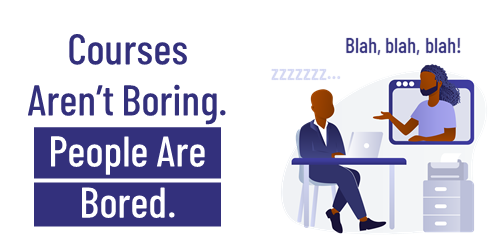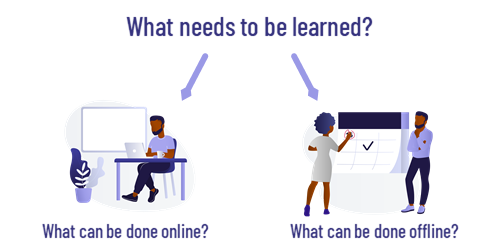Three Ways to Create Engaging Courses that Aren’t Boring
Author:
Go to Source

In a recent post we looked at boring course content. I am not convinced that there is any boring content. I do think there are bored people.
Today we’ll look at how to deal with the bored people when building e-learning courses.
E-Learning Courses Should Be Relevant and Meaningful
There’s a lot to learn about instructional design with all the theories and models. But when it comes down to it, the key ingredient is that the course has meaning to the person who takes it. If you read this blog enough, you’ll see that repeatedly.
One of the challenges to this is that many courses have little to do with the learner or their needs. A lot of compliance and annual training falls into that category. The goal isn’t learning per se. Instead, it’s to track exposure. In that setting, it’s difficult to cater courses to relevant activities because the content tends to be general and not specific to function. And the goal is an end-of-year completion report.

Assuming you do have control over the course structure, framing the content in a meaningful way is important.
I always say, “Throw them in the pool.”
Put the learners in the place where they need to know and use the course content. Don’t focus on the information, focus on the desired action. And then build a course around those activities where they can both learn by doing and demonstrate their understanding.
Skip the Course and Focus on Leading Questions
Do we really need a “course” to teach? Why not frame the content around relevant questions and then present the answers (hopefully desired actions) to them?
You could create a traditional FAQ type structure of questions with answers. It forces you to frame the content into a more meaningful context and not just focus on presenting information.

Another way to deal with a question and answer structure is to build simple scenarios. No need to overbuild the course. They don’t need to be big elaborate media creations. They can be simple questions with a few real-world choices that lead to answers.
Keep the Learning Where the Learning Happens
A great e-learning course may take a few hours for the learner to complete. But a work week is at least forty hours. And depending on the task, proficiency requires more than a couple of hours of practice. Probably at least a couple of weeks.
Where is most of the learning going to happen? In your e-learning course? Or will it happen in their daily interactions with real people, making real decisions?
A good e-learning course is just part of the training solution. Blend the online activity with real-world activities. I like to use the online course to ensure consistent and timely delivery of the core content. And then create training activities in the real world.

An easy thing is to create a list of tasks that require proficiency. Then determine how they practice them and get feedback. I like to use learning journals and peer coaches. Regardless of how you do it, the learning happens mostly outside of the online course, thus it’s good to consider that when building the learning experience.
Remember, the course is a means to an end. The goal isn’t to take a course. The goal is that the course enables some practical learning which produces some measurable results.
Download the fully revised, free 63-page ebook: The Insider’s Guide to Becoming a Rapid E-Learning Pro
Upcoming E-Learning Events
- October 6: Amsterdam. 10 Production Tips from the E-Learning Challenges by David Anderson. Register here.
- October 21: Sydney. 3-Hour Articulate Virtual Event: 10 Production Tips from the E-Learning Challenges, Creating Engaging Software Training in Rise 360, and more. Register here.
- October 29: ATD Nashville. Here’s Why You Need an E-Learning Portfolio.
Free E-Learning Resources
 |
 |
 |
|
Want to learn more? Check out these articles and free resources in the community. |
Here’s a great job board for e-learning, instructional design, and training jobs |
Participate in the weekly e-learning challenges to sharpen your skills |
 |
 |
 |
|
Get your free PowerPoint templates and free graphics & stock images. |
Lots of cool e-learning examples to check out |
Getting Started? This e-learning 101 series and the free e-books will help. |
